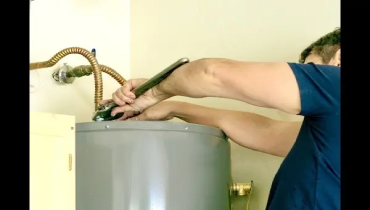
When was the last time you drained your hot water heater tank? Most homeowners won’t recall. Yet, draining a hot water heater tank is crucial for prolonging its service life.
Draining hot water tanks is a helpful preventative maintenance task that can remove sediment buildup and improve the efficiency of your hot water heater to save money. If you don’t prioritize this task yearly, your water may heat more slowly over time, and your water heater may not last as long!
How to Drain a Hot Water Heater
Now that you understand why it’s important to drain a hot water heater tank, you can learn how to do it! Fortunately, learning how to drain a hot water heater is straightforward.
You will need:
- 3-4-foot-long piece of garden hose
- A garden hose fitting to connect to the drain valve at the bottom of the tank
- A bucket (or a floor drain to direct water into)
If you have a gas water heater, switch off the gas and extinguish the pilot light before you get started. If you have an electric water heater, remove the plug from the wall or manually trip the circuit breaker.
Draining a Hot Water Heater Tank:
Before you start draining your hot water heater, it’s important to know that you don’t always have to drain the entire tank. Sediment and buildup can settle on the bottom of the tank. As a result, you can often drain a few gallons of water at a time until you’ve flushed most of the sediment out.
This approach may also reduce the risk of hot water heater damage if you turn it on without water. Refilling your hot water tank can also be much faster if you’re not filling it from empty!
Learn how to drain a hot water heater quickly - take these steps:
- Turn off your hot water tank’s water valve
- Attach the hose to the drain valve at the bottom of the water heater
- Open the drain valve
- Open the pressure relief valve
- Let the water drain into your bucket or floor drain
- Turn on the water supply valve when the tank is empty
- Let the water move through the tank and out the drain valve until you notice it running clear
- Close the drain valve and pressure relief valves to let the tank refill
- If you have an electric water heater, plug the water heater back into your power supply or flip the circuit breaker
- If you have a gas water heater, turn the gas back on and light the pilot light
Note: Draining a water heater tank can be straightforward, but it’s not without risks, such as flooding your basement. If your hot water heater valves haven’t been used in a while or are made of plastic, they can be at risk of leaking. Keep an eye on your valves after you’ve closed them to ensure they’re not leaking or defective. A small drip can become a big problem!
How to Know Your Hot Water Heater Has Sediment Buildup
We don’t always think about draining a hot water heater tank to remove sediment buildup until it’s not operating at its best. You may know your hot water heater has sediment buildup if you notice the following signs:
- No hot water
- Water temperature fluctuations
- Rumbling or popping noises from your tank
- The hot water smells bad or looks rusty
- You notice small leaks near the drain valve
- Water takes a long time to heat up
- The water temperature is less than 120 degrees from your hot water faucet
Contact Mr. Rooter Plumbing for Professional Plumbing Services
Many homeowners feel confident learning how to drain a hot water heater tank and proceeding with this crucial annual task, but that doesn’t mean all homeowners do. Contact your local Mr. Rooter Plumbing or request a job estimate online to save time, hassle, and stress. Do you have a hot water heater emergency? We’re available 24/7 to take your call.
Mr. Rooter Plumbing is here to help whether you need to drain your hot water heater, repair it, or replace it. We’re dedicated to ensuring homeowners throughout Canada can have functioning hot water heaters and avoid cold showers!
Why Choose Mr. Rooter Plumbing?
You deserve to have access to trained service professionals you can trust. Whether you’re draining a hot water heater tank, installing a new one, or needing other plumbing services in Canada, look no further than Mr. Rooter Plumbing.
- Licensed and insured service professionals
- Professionalism and courtesy
- Upfront pricing
- Workmanship and parts guaranteed
- Scheduled appointment times
- Locally owned and operated
This blog is made available by Mr. Rooter LLC for educational purposes only to give the reader general information and a general understanding of the specific subject above. The blog should not be used as a substitute for a licensed plumbing professional in your state or region. Check with city and state laws before performing any household project.

